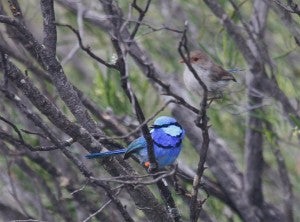
La página que intenta visitar sólo está disponible en inglés. ¡Disculpa!
The page you are about to visit is currently only available in English. Sorry!

 A male (left) and female (right) splendid fairy-wren in Australia. Photo by Mitchell Walters |
The trick is as old as the movies: Take your date to a horror flick, then wait until she gets a fright and she’ll snuggle in close. This “scary movie effect” may also be a strategy some birds use to get lucky, researchers report in the journal Behavioral Ecology.
Splendid fairy-wrens form lifelong pairs, but they’re hugely promiscuous. They mate almost exclusively outside their partnerships.
While studying their complex behavior in Australia, researchers noticed that males don’t fly off when a predator or threat appears. Instead, they immediately sing a distinct call, the “Type II song.” Despite its drab moniker, the song seems to turn nearby females’ heads.
To test the response, Stephen Pruett-Jones, a University of Chicago ecologist, and Emma Greig, now a postdoctoral researcher at Cornell University, played three songs in various combinations at the Brookfield Conservation Park in South Australia: a predator’s song (the butcherbird); fairy-wren territory calls; and Type II song.
Females strongest response was to the butcherbird-Type II combo. They looked in the direction of the call and sang in response.
“It seems that male fairy-wrens may be singing when they know they will have an attentive audience, and, based on the response of females, this strategy may actually work,” says Greig. “The most exciting possibility is that Type II songs have a sexual function, and that females are more easily stimulated by, or receptive to, displays after being alerted by a predator, such that the male’s song is especially attractive.”
Greig and Pruett-Jones looked for other explanations. Perhaps males were signaling their physical—and reproductive—fitness by intentionally putting themselves in danger. But they found no difference in males that sang Type II songs after the predator call.
Now, Craig is back in Australia, investigating whether other avian species employ the scary movie effect as a mating strategy. (Click here for “The Original Oz”, features editor Rene Ebersole’s story about birding in Australia’s Northern Territory.)
I’ll be interested to see what she finds out. In the meantime, I've got some anecdotal evidence that points to the scary movie effect working for both sexes when it comes to humans. While viewing “The Others,” starring Nicole Kidman, at a theater several years ago, my date was startled so badly that he half jumped into my lap.